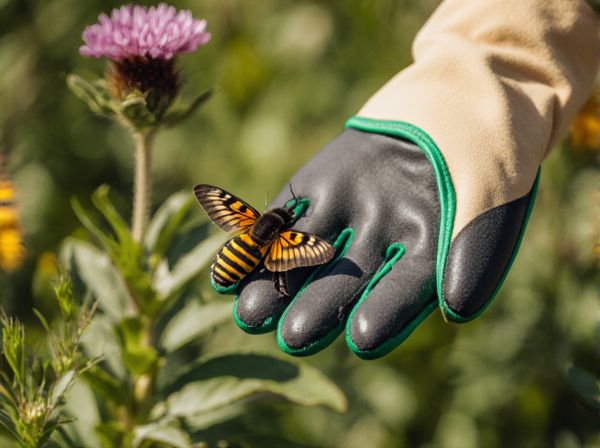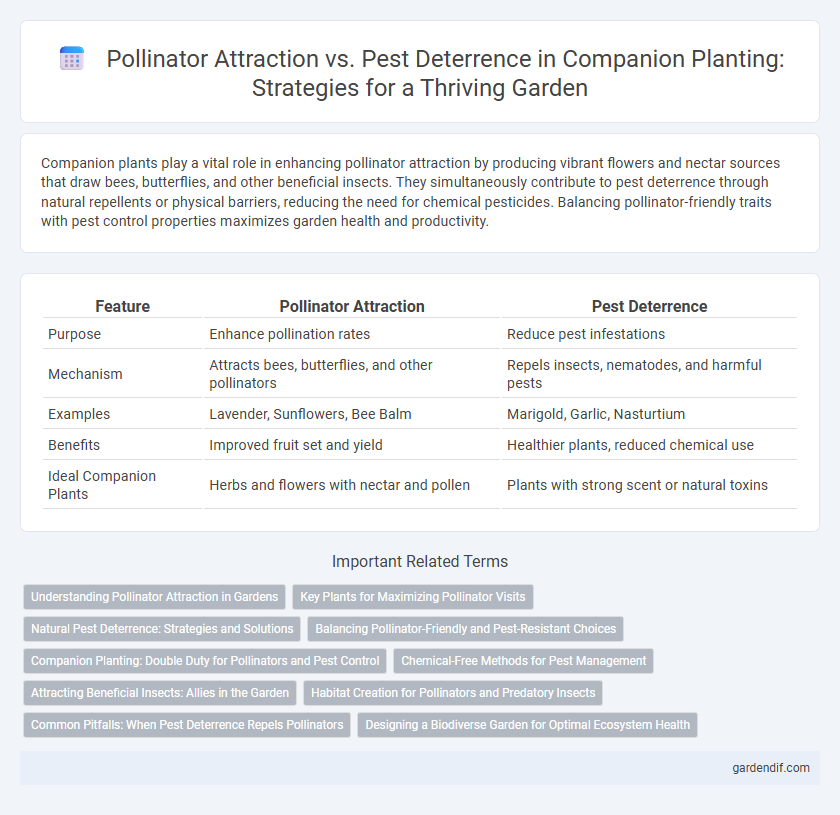
Pollinator attraction vs pest deterrence Illustration
Companion plants play a vital role in enhancing pollinator attraction by producing vibrant flowers and nectar sources that draw bees, butterflies, and other beneficial insects. They simultaneously contribute to pest deterrence through natural repellents or physical barriers, reducing the need for chemical pesticides. Balancing pollinator-friendly traits with pest control properties maximizes garden health and productivity.
Table of Comparison
| Feature | Pollinator Attraction | Pest Deterrence |
|---|---|---|
| Purpose | Enhance pollination rates | Reduce pest infestations |
| Mechanism | Attracts bees, butterflies, and other pollinators | Repels insects, nematodes, and harmful pests |
| Examples | Lavender, Sunflowers, Bee Balm | Marigold, Garlic, Nasturtium |
| Benefits | Improved fruit set and yield | Healthier plants, reduced chemical use |
| Ideal Companion Plants | Herbs and flowers with nectar and pollen | Plants with strong scent or natural toxins |
Understanding Pollinator Attraction in Gardens
Pollinator attraction in gardens hinges on selecting plants with vibrant colors, fragrant blooms, and nectar-rich flowers that appeal to bees, butterflies, and hummingbirds. Native flowering plants and herbs like lavender, coneflower, and milkweed significantly boost pollinator visits, enhancing fruit and seed production. Understanding the behavior and preferences of key pollinators allows gardeners to create habitats that increase pollination efficiency while naturally minimizing pest presence.
Key Plants for Maximizing Pollinator Visits
Key plants to maximize pollinator visits include native wildflowers like echinacea, milkweed, and goldenrod, which provide abundant nectar and pollen throughout the growing season. Incorporating herbs such as lavender, thyme, and borage enhances pollinator attraction while supporting beneficial insects that naturally deter pests. Selecting diverse, flowering plants tailored to local ecosystems optimizes pollinator activity and contributes to effective pest management in companion planting.
Natural Pest Deterrence: Strategies and Solutions
Natural pest deterrence employs companion planting strategies that enhance pollinator attraction while simultaneously repelling harmful insects. Incorporating flowering plants such as marigolds, nasturtiums, and lavender promotes beneficial pollinators like bees and butterflies, which help improve crop yields and biodiversity. These plants produce volatile organic compounds and secondary metabolites that naturally discourage pests, reducing the need for synthetic pesticides and fostering a balanced ecosystem.
Balancing Pollinator-Friendly and Pest-Resistant Choices
Balancing pollinator attraction with pest deterrence requires selecting companion plants that offer nectar and pollen sources to beneficial insects while emitting natural compounds that repel harmful pests. Plants such as marigolds, nasturtiums, and lavender attract bees and butterflies, which improve pollination, yet their strong scents or secondary metabolites can reduce pest infestation. Effective companion planting integrates species that support pollinator health without compromising pest resistance, promoting a sustainable garden ecosystem.
Companion Planting: Double Duty for Pollinators and Pest Control
Companion planting enhances garden ecosystems by simultaneously attracting pollinators like bees and butterflies while deterring common pests such as aphids and beetles. Strategic plant pairings, such as marigolds with tomatoes, release natural chemicals that repel harmful insects while offering nectar sources for pollinators. This dual functionality supports healthier crops, boosts pollination rates, and reduces the need for chemical pesticides, promoting sustainable gardening practices.
Chemical-Free Methods for Pest Management
Companion planting enhances pollinator attraction by utilizing fragrant flowers and nectar-producing plants that boost crop yields without relying on synthetic chemicals. Chemical-free pest deterrence methods include planting aromatic herbs like basil and garlic, which emit natural compounds repelling harmful insects while supporting beneficial pollinators. Integrating diverse plant species fosters a balanced ecosystem, reducing pest populations and promoting sustainable, eco-friendly pest management.
Attracting Beneficial Insects: Allies in the Garden
Attracting beneficial insects like bees, butterflies, and predatory wasps enhances pollination and natural pest control, boosting garden health and crop yields. Companion plants such as marigolds, dill, and fennel emit specific scents or provide nectar that lure these allies, increasing their presence and activity. This natural ecosystem balance reduces the need for chemical pesticides, promoting sustainable and organic gardening practices.
Habitat Creation for Pollinators and Predatory Insects
Creating habitats that support diverse flowering plants and native vegetation enhances pollinator attraction by providing essential nectar and pollen resources. These habitats simultaneously foster predatory insects like ladybugs and lacewings, which naturally deter pests by preying on harmful insect populations. Integrating such habitat features in companion planting strategies promotes ecological balance and reduces the need for chemical pest control.
Common Pitfalls: When Pest Deterrence Repels Pollinators
Overusing pest deterrent plants can inadvertently reduce pollinator visits by emitting scents or chemicals that repel beneficial insects like bees and butterflies. Selecting companion plants requires balancing pest repellent traits without compromising nectar availability or floral attractiveness crucial for pollinator activity. Understanding specific plant-pollinator-pest interactions helps avoid common pitfalls where pest management harms pollination services.
Designing a Biodiverse Garden for Optimal Ecosystem Health
Designing a biodiverse garden enhances pollinator attraction by incorporating native flowering plants that provide ample nectar and pollen throughout the growing season. Strategic plant selection and spatial arrangement reduce pest populations naturally by encouraging beneficial insect predators and creating habitat diversity. This balance of attracting pollinators while deterring pests promotes ecosystem resilience and sustainable garden health.
Pollinator attraction vs pest deterrence Infographic

 gardendif.com
gardendif.com